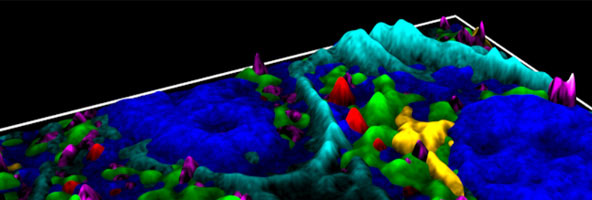Fluorescence microscopy is one of the most powerful tools employed in basic life sciences because it allows detection of different molecular components in cells with high specificity and ultimate sensitivity. This is performed by labelling the molecules of interest using fluorophores that will light up their location and concentration in the cell. To distinguish between different subcellular structures or molecules, fluorophores having different emission spectra (i.e., colours) are commonly used. Imaging is then performed sequentially, that is, one colour at a time, in order to minimize colour cross-talk that arises from the large overlap between the emission spectra of the different fluorophores. This colour cross-talk prevents the acquisition of simultaneous multicolour images, as a consequence hampering the application of such a powerful approach to living cell studies.

Figure: Simultaneous multicolour confocal image of six different organelles (nucleus, actin, mitochondria, lipid droplets, lysosomes and Golgi) labelled on a HeLa cell.
To break through this colour cross-talk barrier, we turned the problem of multicolour fluorescence detection to the excitation side by relying on the absorption properties of the fluorophores, instead of their emission. This is indeed possible because fluorescence emission is directly proportional to the absorption cross-section of the fluorophore at a given excitation wavelength. To implement this experimentally, we modulated our different excitation wavelength lasers at different frequencies, one for each wavelength. The frequency modulations shift the spectroscopic wavelength axis into a frequency-domain measurement eliminating the need to filter the corresponding fluorescence emissions, so that measurements can be performed in a colour-blind fashion with the use of a single detector. A fast Fourier transform then converts the detected time-resolved photon stream into an analog frequency domain signal, from where the relative amplitudes at each given modulated frequency are retrieved to generate excitation maps for each wavelength.
As a result, our newly developed technology enables the simultaneous acquisition of multicolour fluorescence images. We demonstrated the sensitivity of the technique by simultaneously detecting individual fluorescent molecules in multiple colours without compromising integration times or imaging contrast. Moreover, we also implemented a non-negative matrix factorization algorithm for spectral unmixing to extend the number of colour-targets that can be discriminated in a single measurement. Using this algorithm we resolved six spectrally- and spatially-overlapping fluorophores on fixed cells using four excitation wavelengths. The methodology is fully compatible with live imaging of biological samples and can be easily extended to other imaging modalities, including super-resolution microscopy, making simultaneous multicolour imaging more accessible to the biological research community.
This work has been supported by different funding bodies, including HFSP. In particular, our HFSP Program Grant provided the means to take this project off the ground, motivated by the need to simultaneously visualize the organization of different molecular components of the cell membrane upon the action of mechanical forces. Applications of this technology in biology go far beyond the ones we initially conceived. It will allow investigation of multi-molecular processes at different spatial and temporal scales. Visualizing intracellular choreography, watching how different molecules interact with each other or how they play with each other in a spatiotemporal orchestrated manner to reach their function, are now all within reach.
Reference
Frequency-encoded multicolor fluorescence imaging with single-photon-counting color-blind detection E. T. Garbacik, M. Sanz-Paz, K. J. Borgman, F. Campelo, M. F. Garcia-Parajo. Biophys. J. 115, 725-736 (2018)


































